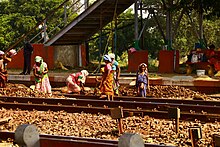
Back فقراء عاملون Arabic Работещи бедни Bulgarian শ্রমজীবী দরিদ্র Bengali/Bangla Pracující chudoba Czech Пролетариат юра ерни CV Arbejdende fattige Danish Erwerbsarmut German Trabajadores pobres Spanish Palgavaene Estonian شاغلان فقیر Persian
This article is written like a personal reflection, personal essay, or argumentative essay that states a Wikipedia editor's personal feelings or presents an original argument about a topic. (November 2014) |
The examples and perspective in this article deal primarily with the United States and do not represent a worldwide view of the subject. (July 2019) |

The working poor are working people whose incomes fall below a given poverty line due to low-income jobs and low familial household income. These are people who spend at least 27 weeks in a year working or looking for employment, but remain under the poverty threshold.[1]
In the US, the official measurement of the working poor is controversial. Many social scientists argue that the official measurements used do not provide a comprehensive overview of the number of working poor. One recent study proposed over 100 ways to measure this and came up with a figure that ranged between 2% and 19% of the total US population.[2]
There is also controversy surrounding ways that the working poor can be helped. Arguments range from increasing welfare to the poor on one end of the spectrum to encouraging the poor to achieve greater self-sufficiency on the other end, with most arguing varying degrees of both.
- ^ Sykes, Jennifer; Križ, Katrin; Edin, Kathryn; Halpern-Meekin, Sarah (April 2015). "Dignity and Dreams: What the Earned Income Tax Credit (EITC) Means to Low-Income Families". American Sociological Review. 80 (2): 243–267. doi:10.1177/0003122414551552. ISSN 0003-1224. S2CID 154685898.
- ^ Thiede, Brian C., et al. "America's Working Poor: Conceptualization, Measurement, and New Estimates." Work and Occupations, vol. 42, no. 3, Aug. 2015, pp. 267–312, doi:10.1177/0730888415573635
© MMXXIII Rich X Search. We shall prevail. All rights reserved. Rich X Search